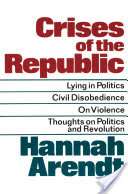Crises of the Republic
Crises of the Republic[1] is an anthology of four essays by Hannah Arendt, dealing with contemporary American politics and the crises it faced in the 1960s and 1970s, published in 1972.
 | |
| Author | Hannah Arendt |
|---|---|
| Country | United States |
| Subject | Politics |
| Genre | Political theory |
| Publisher | Harcourt Brace Jovanovich |
Publication date | 1972 |
Structure
Crises of the Republic was the third of Arendt's anthologies, and as the subtitle Lying in Politics, Civil Disobedience, On Violence, Thoughts on Politics and Revolution indicates, consists of four interconnected essays on contemporary American politics and the crises it faced in the 1960s and 1970s. The first essay, "Lying in Politics" looks for an explanation behind the administration's deception regarding the Vietnam War, as revealed in the Pentagon Papers. "Civil Disobedience" examines the opposition movements, while the final "Thoughts on Politics and Revolution" is a commentary, in the form of an interview on the third essay, "On Violence".[1][2]
"On Violence"
In "On Violence", the third of these essays, Arendt breaks with the predominant conception of power as derived from violence, and that violence is an extreme manifestation of power. Power and violence are separate phenomena:
Power and violence are opposites; where the one rules absolutely, the other is absent. [3]
The explanation is that governmental violence requires organisation, i.e. power:
In a contest of violence against violence the superiority of the government has always been absolute; but this superiority lasts only as long as the power structure of the government is intact — that is, as long as commands are obeyed and the army or police forces are prepared to use their weapons. ... Where power has disintegrated, revolutions are possible but not necessary. [4]
More generally, Arendt defines power as property of a group:
Power corresponds to the human ability not just to act but to act in concert. Power is never the property of an individual; it belongs to a group and remains in existence only so long as the group keeps together. When we say of somebody that he is "in power" we actually refer to his being empowered by a certain number of people to act in their name. [5]
Though violence is not a precondition for power, it may nevertheless be a means of power.
Power is indeed of the essence of all government, but violence is not. Violence is by nature instrumental; like all means, it always stands in need of guidance and justification through the end it pursues. And what needs justification by something else cannot be the essence of anything. [6]
Bureaucracies then attract violence since they are defined as the "rule by no one" against whom to argue. Thus, Bureaucracies exclude the relations with the people they rule over. [7]
References
- Arendt 1972.
- Nott 1972.
- Arendt 1972, p. 30.
- Arendt 1972, p. 26.
- Arendt 1972, p. 24.
- Arendt 1972, p. 27.
- Arendt 1972, p. 41.
Bibliography
- — (1972). Crises of the Republic: Lying in Politics, Civil Disobedience on Violence, Thoughts on Politics, and Revolution. New York: Harcourt Brace Jovanovich. ISBN 978-0-15-623200-5.CS1 maint: ref=harv (link)[lower-alpha 1]
- Lying in Politics full text
- Nott, Kathleen (1 August 1972). "Crises of the Republic, by Hannah Arendt". Commentary (Review). Retrieved 23 July 2018.CS1 maint: ref=harv (link)
Bibliographic notes
- "Civil Disobedience" originally appeared, in somewhat different form, in The New Yorker. Versions of the other essays originally appeared in The New York Review of Books